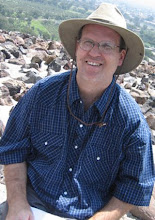Tuesday, October 20, 2009
+ Join me on FACEBOOK - Or you're missing out on all my best posts lately + www.TedsBook.com
http://www.TedsBook.com
Sub-audible frequency generation techniques (REDUX)
Just for my own reference (again)... But you can play too, if you like...
http://www.youtube.com/watch?v=oJ2nF1w5opU
http://www.rotarywoofer.com/
http://en.wikipedia.org/wiki/Leslie_speaker
http://en.wikipedia.org/wiki/Rotary_woofer
http://en.wikipedia.org/wiki/Low_frequency
http://en.wikipedia.org/wiki/Sub-bass
http://en.wikipedia.org/wiki/Subwoofer
http://en.wikipedia.org/wiki/Bass_test
http://en.wikipedia.org/wiki/Spectrum
http://en.wikipedia.org/wiki/Infrasound
http://en.wikipedia.org/wiki/Brown_note
http://en.wikipedia.org/wiki/Low-frequency_effect
http://en.wikipedia.org/wiki/Tactile_transducer
http://www.nutshellhifi.com/library/speaker-design1.html
http://en.wikipedia.org/wiki/Surround_sound
http://en.wikipedia.org/wiki/Ionization
http://en.wikipedia.org/wiki/Plasma_(physics)
http://en.wikipedia.org/wiki/Plasma_speaker
http://en.wikipedia.org/wiki/Plasmaphone
http://en.wikipedia.org/wiki/God_helmet
Tuesday, August 18, 2009
+ Welcome to QUEEN CALIFIA-ORNIA - The Legendary Black Death Warrior Goddess Who Builds Cities by the Sea +
Watch out - She's a hottie, rrrrr...

Califia
From Wikipedia, the free encyclopedia
Califia (aka Calafia) is the name of a legendary Black Amazon warrior queen, associated with the mythical Island of California. The US state of California is thought by some to be named after Queen Califia (see Origin of the name California).
The legend of Queen Califia appears to date back to the novel Las sergas de Esplandián (The Adventures of Esplandián), written around 1510 by the Spanish writer Garci Rodríguez de Montalvo:
It is known that to the right of the Indies there exists an island called California very near the terrestrial paradise; and peopled by black women among whom there was not a single man since they lived in the way of the Amazons. They had beautiful robust bodies, spirited courage and great strength. Their island was the most impregnable in the world with its cliffs and headlands and rocky coasts. Their weapons were all of gold . . . because in all the island there was no metal except gold. And there ruled over that island of California a queen of majestic proportions, more beautiful than all others, and in the very vigor of her womanhood. She was not petite, nor blond, nor golden-haired. She was large, and black as the ace of clubs. But the prejudice of color did not then exist even among the most brazen-faced or the most copper-headed. For, as you shall learn, she was reputed the most beautiful of women; and it was she, O Californias! who accomplished great deeds, she was valiant and courageous and ardent with a brave heart, and had ambitions to execute nobler actions than had been performed by any other ruler — Queen Califia.
This document helped to precipitate the Spanish hunt for gold in North America. In 1536 when the explorer Hernán Cortés landed with his crew in what is known today as Baja California, they believed that they had arrived in Califia's land. A portion of the original of this document Las sergas de Esplandián was translated by Edward Everett Hale for The Antiquarian Society, and the story was printed in the Atlantic Monthly magazine in 1864.[1] By 1770, the entire Pacific coast controlled by Spain had been given the name California, and the Spanish speaking people who lived there were called Californios.
California Amazons
Dora Beale Polk, The Island of California, A History of the Myth, page 126:
In describing his California Amazons as "mujeres negras" Montalvo was following the color prejudices of the period. In his time, and in some places still, black describes any complexion other than white. John Mandeville describes a tribe neighboring his Amazons as "black enough and more than black . . . and they be clept Moors." When the explorers met the inhabitants of what they believed was "Ind," they lumped them automatically into the dark-skinned category. Attitudes from the New World, the Crusades, and the invasion of the Moors were fused in Montalvo's California Amazons.[2]

"Golden Dreams" was a 23-minute film showing the history of California through several recreated scenes, narrated by Whoopi Goldberg as Califia, the Queen of California. The attraction, atDisney's California Adventure at the Disneyland Resort in Anaheim, California, opened with the park on February 8, 2001, and closed on September 7, 2008. It is open only to school groups until April of 2009, when it will be demolished to make way for the construction of a Little Mermaid dark ride.
---
Origin of the name California
From Wikipedia, the free encyclopedia
This 1562 map by Diego Gutiérrez was the first map to print the toponym California.
The toponym California is currently used by three North American entities—in the United States, by the state of California; and in Mexico, by the states ofBaja California ("Lower California") and Baja California Sur ("South Lower California") (collectively, these three areas constitute Las Californias)—and shared by many other places in other parts of the world whose names derive from these.
Alta California ("Upper California") was the name of the State of California when it was still part of Mexico, and the Sea of Cortés is also known as theGulf of California.
Several origins have been suggested for the word "California", includingSpanish, Latin, South Asian, and Aboriginal American origins. All of these are disputed.[1] The following paragraphs illustrate some of the extant claims.
California originally referred to the entire region composed of the Mexican peninsula now known as Baja California and land in the current US states of California, Nevada, Utah, Arizona, and Wyoming, which was eventually distinguished as Alta California. In even earlier times, the boundaries of the Sea of Cortés and the Pacific shore were only partially explored and California was shown on early maps as an island.
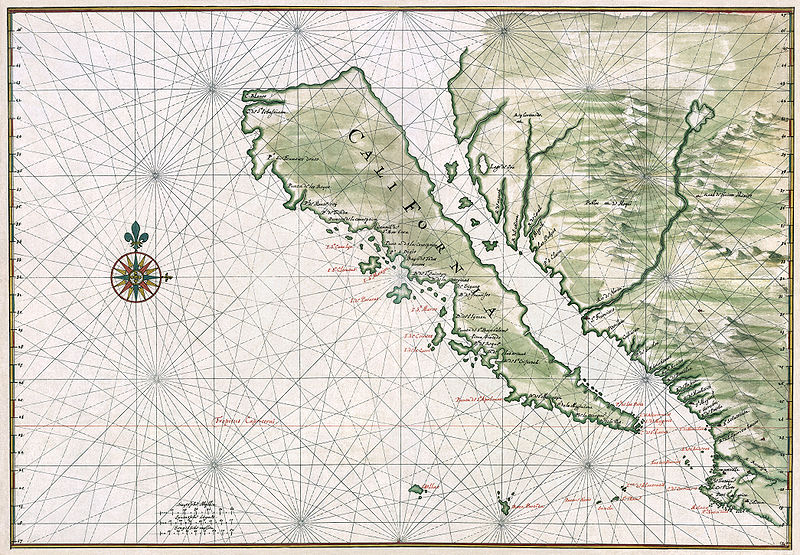
In the minds of European explorers, an island populated by Amazons off the coast of the Indies was a long-established expectation. The earliest known application of the name "California" to this island of the Amazons was in the romance novel Las Sergas de Esplandián (The Adventures of Esplandián) by Spanish author Garci Rodríguez de Montalvo, whose earliest surviving edition (but not first edition) is from 1510. The book described the Island of California as being east of theAsian mainland, "very close to the side of the Terrestrial Paradise; and it is peopled by blackwomen, without any man among them, for they live in the manner of Amazons." The Island was ruled by Queen Califia. In his work, the author drew on a long-standing European belief in such an island.
Know that on the right hand from the Indies exists an island called California very close to a side of the Earthly Paradise; and it was populated by black women, without any man existing there, because they lived in the way of the Amazons. They had beautiful and robust bodies, and were brave and very strong. Their island was the strongest of the World, with its cliffs and rocky shores. Their weapons were golden and so were the harnesses of the wild beasts that they were accustomed to domesticate and ride, because there was no other metal in the island than gold.
–Las Sergas de Esplandián, (novela de caballería)
by García Ordóñez de Montalvo.
Published in Seville in 1510.
Since then, that unknown Amazon's Island came to be known as California.
Some scholars speculate the Song of Roland, an 11th century Old French epic poem, may have served as the inspiration for the nameCalifornia. It refers to the defeat suffered August 15, 778, in the retreat of Charlemagne's army at the hands of the Muslim army inBattle of Roncevaux Pass in the Pyrenees. On line 2924 of the poem, which is in verse number CCIX (209), the word Califerne is one of the lands mentioned, with no indication of its geographic location. It is, however, named after a reference to Affrike, or Africa.
Morz est mis nies, ki tant me fist cunquere
Encuntre mei revelerunt li Seisne,
E Hungre e Bugre e tante gent averse,
Romain, Puillain et tuit icil de Palerne
E cil d'Affrike e cil de Califerne.
My nephew's dead, who won for me such realms!
Against me then the Saxon will rebel,
Hungar, Bulgar, and many hostile men,
Romain, Puillain, all those are in Palerne,
And in Affrike, and those in Califerne;
–Song of Roland, Verse CCIX (i.e. 209; lines 2920–2924), 11th c.
"Since the Roland poem concerns the "evil" Saracens, it's possible that the poet derived Califerne from caliph. Montalvo might also have been influenced by such similar names as Californo and Calafornina in Sicily or Calahorra in Spain."[2]
This notion of a place of women without men echoes a passage from the diary of Christopher Columbus's first voyage:
The Indians told him that along that route he would find the island of Matinino, which they said was populated by women without men, to which the admiral replied he wanted very much to bring five or six of them to the king and queen… but they said that it was certain that they [the women] existed and that at a certain time of the year men came to them [women] from the aforementioned island of Carib, which they said was ten or twelve leagues away, and if they gave birth to a son they sent it to the island of the men, and if a girl, they kept her with them.
The lure of an earthly paradise, as well as the search for the fabled Strait of Anián, helped motivate Hernán Cortés,[citation needed]following his conquest of Mexico, to send several expeditions in the late 1530s and early 1540s to the west coast of New Spain. The first expedition reached the Gulf of California and Baja California, and proved that California was in fact a peninsula. Nevertheless, the idea that California was an island persisted for well over a century and was included on many maps. The Spanish gave the name "California" to the peninsula and to the lands north, including both Baja California and Alta California, the region that became the present-day US state.
Fourth carta de relación of Hernán Cortés
In his fourth carta de relación (a letter to Spain narrating events of the conquest), datelined Mexico (meaning what is now Mexico City)15 October 1524, Hernán Cortés wrote to the king of Spain about certain information about a legendary island, information that had been brought to him by the captain who had achieved the conquest of Colima.
And in the same manner I was brought a story from the men of the province of Cihuatlán, which reinforced completely that there is an island populated by women, without a single male, and at certain times men come from the mainland, who are granted access by the women… and if they give birth to women [sic], they keep them; and if men, they throw them out of their company; and that this island is ten days journey from this province; and that many of them have gone there and have seen it. They tell me also that it is very rich in pearls and gold; I will prepare myself to know the truth and tell it at length to your majesty.
–Hernán Cortés. Fourth carta de relación.
The name of California is applied
The name California is the fifth-oldest surviving European place-name in the US and was applied to what is now the southern tip ofBaja California as the island of California by a Spanish expedition led by Diego de Becerra and Fortun Ximenez who landed there in 1533 at the bequest of Hernando Cortes.[3]
Cortés, on his third journey of exploration (1535–36), tried unsuccessfully to establish a colony at La Paz near the southern tip of the recently discovered Baja California Peninsula under a royal charter granting him that land.
Hernando de Alarcón, sent by the viceroy Mendoza—an enemy of Cortés—on a 1540 expedition to verify Cortés's discoveries, referred to the inhospitable lands as California, after the imaginary island in Las Sergas, discussed above. There is no question about Hernando de Alarcón's use of the term, nor about his allusion to Las Sergas, but there is question as to whether this is the first use of the name to refer to those lands and whether he intended the name as mockery. Alarcón provides a clear link from the literary, imaginary California to the real place, but his usage cannot be proven to be the actual origin, in that the name might predate him.[4][5][6]
Today the name California is applied to the Baja California Peninsula, the Gulf of California (also known as the Sea of Cortés), the US State of California, and the Mexican states of Baja California and Baja California Sur.
Queen Califia's Magical Circle Garden
Escondido, California

Queen Califia is the legendary Amazon queen that California is named after. She is 11 feet tall and stands atop a 13-foot tall eagle.
 That's tall!
That's tall!
There are tall totems surrounding the queen and eagle. They have a variety of all sorts of different creatures and symbols on them. The artist, Niki de Saint Phalle, took a mix of legends and myths from many different cultures all over the world and put them together in bright colorful totems.
---
and then we have the Original KALI -
Kali is a destructive and devouring Hindu goddess. She is a terrifying aspect of Devi, who in other forms appears as peaceful and benevolent. Kali is commonly associated with death, violence, sexuality, and, paradoxically, with motherly love. Noted for killing the demon Raktavija, she is usually depicted as a hideous, black-faced hag smeared with blood. In her four hands she holds, variously, a sword, a shield, the severed head of a giant, or a noose for strangling. Nearly naked, she wears a garland of skulls and a girdle of severed hands. She is often shown standing or dancing on her husband, Shiva. Until the 19th century the thugs of India worshiped Kali and offered their victims to her. In the late 20th century she became a symbol of feminine empowerment in some circles.
---
Kali
From Wikipedia, the free encyclopedia
Kali
Kali (Sanskrit: Bengali: both Kālī), also known as Kalika(Bengali: Kālikā), is a Hindu goddess associated with eternal energy. The name Kali means "black", but has by folk etymology come to mean "force of time (kala)". Despite her negative connotations, she is today considered the goddess of time and change. Although sometimes presented as dark and violent, her earliest incarnation as a figure of annihilation still has some influence. More complex Tantric beliefs sometimes extend her role so far as to be the "ultimate reality" or Brahman. She is also revered as Bhavatarini (literally "redeemer of the universe"). Comparatively recent devotional movements largely conceive Kali as a benevolent mother goddess.
Kali is represented as the consort of god Shiva, on whose body she is often seen standing. She is associated with many other Hindu goddesses like Durga,Bhadrakali, Sati, Rudrani, Parvati and Chamunda. She is the foremost among the Dasa-Mahavidyas, ten fierce Tantric goddesses.[1]

Monday, May 18, 2009
+ Mystery Of America- Time Travellers From Our Past w/ Tedd St. Rain (2 hour video & free ebook) +
+ Mystery Of America- Time Travellers From Our Past w/ Tedd St. Rain (2 hr vid & free ebook) +
<embed id="VideoPlayback" src="http://video.google.com/googleplayer.swf?docid=-4540067720141552774&hl=en&fs=true" style="width:400px;height:326px" allowFullScreen="true" allowScriptAccess="always" type="application/x-shockwave-flash"> </embed>
Mystery of America - Enigmatic Mysteries and Anomalous Artifacts of North America: A Connection to the Ancient Past, by Tédd St. Rain. Mysterious and often inexplicable remnants of civilization's history fascinate scientists and archaeologists. People travel worldwide to visit such sites, yet some of the most enigmatic artifacts and structures have been found right here in North America. Unfortunately, because these records do not fit within accepted academic models of human history, they remain unexplained mysteries, and most people never hear of them. Long before any humans were supposed to be on this continent, unknown hands removed millions of pounds of copper from mines near Lake Superior. Or a three-foot-high adult mummy was discovered in Wyoming. Sandaled feet made footprints in rock at least 300 million years old. A human-like tooth,three times normal size, was found in coal from a Montana mine. According to modern wisdom, humans evolved on Earth no earlier than two million years ago. Yet many of these artifacts were made long before then. How can this be? Could these anomalies have been the result of an advanced civilization once present on our planet? This video-taped lecture presents evidence that there have been intelligent beings on earth long before humans are thought to have evolved here. About 1/2 way through, St. Rain shifts gears and describes the basics of his THEORY OF ALMOST EVERYTHING, fondly referred to as TEDD'S GRAND UNIFIED CONSPIRACY THEORY, where he reveals the nature of the human soul, soul catchers, the interdimensional nature of reality, the reason for the arrival of extraterrestrials, intergalactic vending routes, the prime directive, extinction level events, cosmic dump trucks, Corso's time travelling aliens at roswell, time travel, time dilation, quanta, string theories; and so much more. --- Tedd St. Rain, author, lecturer, and videographer, he has traveled the world extensively investigating the world’s ancient mysteries and enigmas, actively researching the mysterious, the metaphysical and the mythical.
---- ENIGMATIC MYSTERIES AND ANOMALOUS ARTIFACTS OF NORTH AMERICA: A CONNECTION TO THE ANCIENT PAST DOWNLOAD the entire book for FREE in PDF FORMAT by clicking HERE(17.6 megs) LOST ARTS MEDIA MYSTERYOFAMERICA: BOOK 1 ANCIENT CANALS to read the rest (and download your free copy), GO HERE: www.MysteryOfAmerica.com
Also 'READ the FREE E-BOOK' on Scribd.com: Mystery of America - Enigmatic Mysteries and Anomalous Artifacts of North America: A Connection to the Ancient Past, by Tédd St. Rain - All Rites Reversed. 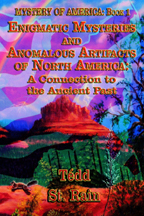 Mysterious and often inexplicable remnants of civilization's history fascinate scientists and archaeologists. People travel worldwide to visit such sites, yet some of the most enigmatic artifacts and structures have been found right here in North America. Unfortunately, because these records do not fit within accepted academic models of human history, they remain unexplained mysteries, and most people never hear of them.
Mysterious and often inexplicable remnants of civilization's history fascinate scientists and archaeologists. People travel worldwide to visit such sites, yet some of the most enigmatic artifacts and structures have been found right here in North America. Unfortunately, because these records do not fit within accepted academic models of human history, they remain unexplained mysteries, and most people never hear of them.
• Long before any humans were supposed to be on this continent, unknown hands removed millions of pounds of copper from mines near Lake Superior.
• Giant people as tall as 12 feet were buried in Arizona, Nevada and the Midwest.
• A three-foot-high adult mummy was discovered in Wyoming.
• Sandaled feet made footprints in rock at least 300 million years old in Utah.
• A human-like tooth,three times normal size, was found in coal from a Montana mine.
According to modern wisdom, humans evolved on Earth no earlier than two million years ago. Yet many of these artifacts were made long before then. How can this be? Could any of these anomalies have been the result of an advanced civilization once present on our planet?
This book presents the evidence that there have been intelligent beings on earth long before humans are thought to have evolved here. Explore these intriguing possibilities and more in this exciting and informative investigation into the mysteries and anomalous artifacts of North America.
Tedd St. Rain, author, lecturer, and videographer, he has traveled the world extensively investigating the world’s ancient mysteries and enigmas, actively researching the mysterious, the metaphysical and the mythical. Born in Long Beach, California, Tedd is the owner of Lost Arts Media that publishes, markets and distributes fascinating and educational books, videos and multimedia products to help inform, enlighten and inspire humanity.
LA-999 o ISBN 1-59016-999-9 o 107 pages o 6 x 9 o trade paper o heavily illustrated o Large Print Edition
Published by:
LONG BEACH, CA
© 1997-2009
Tédd St. Rain
All Rites Reversed
No part of this publication may be reproduced or transmitted in any form or by any means, electronic or mechanical, or be entered or posted on any computer network, or into any present or future information storage or retrieval system, without written permission from the author.
MYSTERYOF AMERICA: BOOK1 – ENIGMATIC MYSTERIES AND ANOMALOUS ARTIFACTS OF NORTH AMERICA:
A CONNECTION TO THE ANCIENT PAST
ISBN 1-59016-999-9
CONCEPT, RESEARCH, LAYOUT AND DESIGN
Tédd St. Rain
ENIGMATIC MYSTERIES AND ANOMALOUS
ARTIFACTS OF NORTH AMERICA:
A CONNECTION TO THE ANCIENT PAST
Presented by Tédd St. Rain
The exact contrary
of what is generally
believed is often the truth.
–Jean de la Bruyere
INTRODUCTION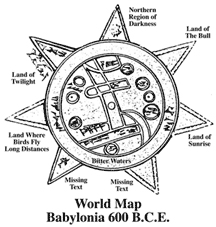 There are many people today who take a great interest in our past and our history as a civilization. The planet on which we live has a number of mysterious and often enigmatic remnants and artifacts that continue to baffle many scientists and archaeologists. There is a recurring theme that many of the ancient relics have in common, that of being of such unwieldy proportions or sophistication, it is hard to believe that primitive human hands alone could have fashioned them. What we do know of the first recorded civilizations indicates they had a high degree of sophistication (even by today’s standards) in many of the fledging arts and sciences we take for granted. These include the development of and expertise in agriculture, writing, mathematics, cosmology, weights and measures, contracts, education, justice, time reckoning, the Zodiac, art, metallurgy, sculpture and painting, amongst many others.
There are many people today who take a great interest in our past and our history as a civilization. The planet on which we live has a number of mysterious and often enigmatic remnants and artifacts that continue to baffle many scientists and archaeologists. There is a recurring theme that many of the ancient relics have in common, that of being of such unwieldy proportions or sophistication, it is hard to believe that primitive human hands alone could have fashioned them. What we do know of the first recorded civilizations indicates they had a high degree of sophistication (even by today’s standards) in many of the fledging arts and sciences we take for granted. These include the development of and expertise in agriculture, writing, mathematics, cosmology, weights and measures, contracts, education, justice, time reckoning, the Zodiac, art, metallurgy, sculpture and painting, amongst many others.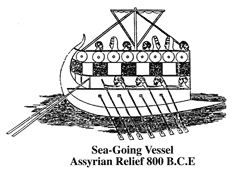 Modern-day research and scholarship have revealed some interesting details of these ancient civilizations that may explain the nearly instantaneous rise of civilization nearly 6,000 years ago (See Sitchin, Freer, Gardner and others in the bibliography). There is mounting evidence that an extraterrestrial influence may have shaped mankind’s early history and may even be responsible for our very existence.
Modern-day research and scholarship have revealed some interesting details of these ancient civilizations that may explain the nearly instantaneous rise of civilization nearly 6,000 years ago (See Sitchin, Freer, Gardner and others in the bibliography). There is mounting evidence that an extraterrestrial influence may have shaped mankind’s early history and may even be responsible for our very existence.
W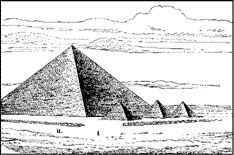 hen one considers ancient mysteries of the world what frequently comes to mind are romantic images of the pyramids of Egypt and Mexico, the crumbling walls of Babylon, and of Greece and Rome, the ruins of Baalbek, the remnants of a lost civilization in the Andes, and many others. People travel all over the world to visit places such as these, and yet some of the most perplexing, enigmatic and profound artifacts and structures have been found right here in North America. It is unfortunate that few people outside of certain circles have heard of these incredible archaeological finds. This book (and companion lecture on Video and DVD) will present evidence supporting the notion that there may have been "others" who have come before us. "Others" who have either left, died out, or have returned from elsewhere, possibly as the modern UFO phenomenon.
hen one considers ancient mysteries of the world what frequently comes to mind are romantic images of the pyramids of Egypt and Mexico, the crumbling walls of Babylon, and of Greece and Rome, the ruins of Baalbek, the remnants of a lost civilization in the Andes, and many others. People travel all over the world to visit places such as these, and yet some of the most perplexing, enigmatic and profound artifacts and structures have been found right here in North America. It is unfortunate that few people outside of certain circles have heard of these incredible archaeological finds. This book (and companion lecture on Video and DVD) will present evidence supporting the notion that there may have been "others" who have come before us. "Others" who have either left, died out, or have returned from elsewhere, possibly as the modern UFO phenomenon.
DEEP WITHIN THE ARCHIVES
A large mountain of evidence available from literary and other sources is available to support the hypothesis that something strange has occurred in the remote past on this planet. Unfortunately, most of the so-called "reputable" institutions have been more interested in piecing together mankind’s historical record than in understanding the significance of the rare and unusual artifacts that from time to time come to their attention. Of much greater concern is the methodical and systematic way in which the authorities and powers-that-be have hidden the truth, oftentimes suppressing evidence that would revise the early history of America, and in many notable cases would completely rewrite the record, and mankind’s place in it, on this planet.
The legendary Vatican archives are an excellent example. There is no doubt that the libraries and storehouses on and below the grounds of the less-than-a-square-mile sovereign republic known as Vatican City contain a wealth of information about mankind’s past. The Vatican library is renowned the world over for its extensive collection on every subject conceivable. There are even rumors of hidden passageways and secret vaults used as safe storage for some of the most incredible curios imaginable. After two millennia of acquisitions, in all likelihood the most unusual of the unusual lie within its walls, literally containing the "secrets of the ages." Astounding artifacts which, if were made public, would revise our understanding and shine the torch of illumination on the complicated history of both the old and new worlds.
The archives of the Smithsonian Institution certainly rival those of the Vatican, in quantity, if not in depth and scope. The Smithsonian Institution was created when its namesake, British scientist James Smithson, bequeathed that his estate should go "to the United States of America, to found at Washington, under the name of the Smithsonian Institution, an establishment for the increase and diffusion of knowledge among men." The motives behind Smithson’s bequest remain mysterious. He never traveled to the United States and seems to have had no correspondence with anyone here.
It should come as no surprise as to how many of the objects described in the literature and acquired by the Smithsonian have become "lost" or "unaccounted for." Many times they acknowledge having received an object, but its present location is unknown, or there is some other problem, as in a notable case from the Crumf Burial Cave. In 1892, there were several wood coffins that had been hollowed out by fire, aided by stone or copper chisels, discovered in a cave near Birmingham, Alabama. Eight of these coffins were reportedly taken to the Smithsonian, which in the 1950s claimed they had "not been able to find the specimens in our collection, though records show that they were received." Later, in 1992, the Smithsonian told the President of the Gungywamp Society, David Barron, that the coffins could not be viewed because they were housed in an asbestos-contaminated warehouse that would be closed for the next ten years, and which no one was allowed into except Smithsonian personnel. It would be interesting to know where the coffins are now.
Over the past nearly couple hundred years the Smithsonian has played a part in many of the archaeological finds in North America, sometimes accepting material after no one else knew what to do with it. As a result they have collected over a million artifacts, only a small number of which are available for public viewing. Because of this involvement, they have become the main storehouse for many of the obscure and hard-to-explain rarities uncovered on American soil. In addition to the Smithsonian, many colleges and universities, among them the University of Pennsylvania, University of Chicago and the University of California, were involved and thus claimed the booty, from many of the 19th and 20th century discoveries. Amongst these various archives, institutions, and museums, open only to a select few, lie human-like remains dug up over the past several centuries. Within the literature exists reference to many of these finds, a number of which refer to burials of humans that would be considered giants by today’s standards. While many of these interments were the result of "mound builder" activity, primarily from the Adena, Hopewell and Mississippian cultures, there have been several notable exceptions where the remains most likely predate any historical habitation in the area.
THERE WERE GIANTS ON THE EARTH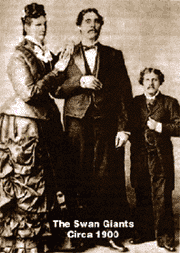 There have been a number of modern-day giants, such as the Swans, a happily-married giant couple from around the turn of the century. What concerns us most, however, is any number of enigmatic oversized skeletons unearthed in America.
There have been a number of modern-day giants, such as the Swans, a happily-married giant couple from around the turn of the century. What concerns us most, however, is any number of enigmatic oversized skeletons unearthed in America.
In a classic example of mound builder activity, an article1 reports that near Brewersville, Indiana, a stone mound more than 70 feet in diameter was excavated, in 1879, which contained skeletons, at least one of which was over nine and half feet tall. At its feet was a human image of burned clay embedded with pieces of flint. Weapons that had been buried nearby were not common to Native Americans in the area. The excavation was supervised by Indiana State archaeologists, and others from the neighborhood states of New York and Ohio. In an affirmation to the lackadaisical attitude of such discoveries in the past, the artifacts were kept in a basket near the Robinson family grain mill, on whose property they had been found. Unfortunately, in 1937 a flood swept the mill away and with it the contents of the basket, which has never been seen since.
Some of the other "giants" which have been found in North America are much more problematic. There are many burials where the nature and characteristics of the burial indicate the skeletal remains are of an uncommonly old age. Take for instance the discovery in a small now-abandoned town southeast of Tucson, Arizona, called Crittenden. According to newspaper accounts2 at the time, there was an astounding discovery which, if it is true, could entirely reshape how we view our past. In 1891, while workmen were digging a basement for a commercial building they made a startling discovery. About eight feet below the surface they discovered a large clay-stone sarcophagus. The contractor then called in expert help, and when they opened it they found a granite mummy case which once held the body of a human-like being more than twelve feet tall. The mummy had worn long hair and a bird-shaped headdress, possibly of an Egyptian motif. Apparently the body had been buried for so many thousands of years that the bones had turned to dust, but inscriptions on the outside of the mummy case indicate that the being had six toes. We must all take reports like this, as we do everything in life, with a grain of salt. Keeping in mind that some of the less scrupulous newspapers of the day would think up stories such as this to fill out the columns. The fact that the alleged discovery it is not an isolated one, and that similar finds can be found throughout North America, does seem to support this report.
THE LOVELOCK GIANTS
Another famous discovery of oversized human remains was first reported3 in 1911, when miners harvesting bat guano at Lovelock Cave (about 80 miles northeast of Reno, Nevada) discovered the skeleton of a large mummified human skeleton. The unusual thing about this particular find, besides its excessive height and the extraordinarily large human skulls, was the fact that the remains showed evidence of red hair and was unlike any Indian known to have lived in North America.
As the workers continued mining past the four-foot level, they continued to discover mummies. A mining engineer and amateur archaeologist, John T. Reid, immediately reported the discovery to numerous colleges and institutions, including the University of Pennsylvania and the Smithsonian Institution. He offered them the opportunity to examine the artifacts as they were being removed from the screens of the mining equipment. Unfortunately, it was over a year before the University of California sent a "non-professional observer," by which time the miners had all but disposed of nearly all the bones and other related artifacts.
Another "observer" who had come later from New York, had accompanied the first man in his observation of the site. What became especially puzzling was that these men went out of their way to avoid examination of the bones, and at one point, even insisted on the reburial of a complete skeleton that had just been unearthed. Instead, they focused their investigation primarily on pottery shards, fragments of basketry, and the like. It is no surprise that it took 17 years, in 1929, before their findings were published, and then, only in a small article from California. Understandably, Reid became disillusioned with the establishment, and began to document the discoveries as best he could. Many of the testimonials he collected, as well as his personal memoirs, and some baskets and beads from the area can be found in the Nevada State Historical Society library and museum at 1650 North Virginia Street, Reno, NV 89503.
After the refusal of "establishment science" to make a serious investigation into the matter, local Lovelock residents set up makeshift exhibits of the more impressive finds. As has been the case many times with priceless relics of our past, a devastating fire at one of these displays ended up destroying much of what remained.
There have been reports of other oversize skeletons turning up in the area. Skeletons were found in February and June of 1931 in the Humboldt lake bed near the cave. One of these was said to have been wrapped in an Egyptian-like gum-covered material and was about eight and a half feet tall, while another, stood nearly ten feet tall. Another report in the 29 Sep 1939 Review Miner tells of a seven-foot-seven-inch skeleton that was found on the Friedman Ranch in the vicinity. As a result of the long series of battles that took place in the area, there may still be quite a few undiscovered finds that would be superficially buried, especially in the area of Carson sink, specifically around the south shore and near Pelican Island. Also, a few miles southwest of Lovelock along the railroad, near Perth, is a gravel pit that has yielded artifacts and mummies. Local Indians claim that artifacts have been found in caves near the Pyramid Lake Reservation about 55 miles to the west.
According to Reid, Indians had told him of petrified giants they had found lying in the open wilderness area to the south of Lovelock Cave. In fact, the local Piute Indians spoke of a race of red-headed giants and the bloody conflict that their forefathers had pursued against them. So ferocious was the Piute abomination toward these Si-Te-Cahs, or "lanky redheads," that a collective crusade to wipe them out was organized by local tribes that were normally at odds with one another. A book published in 1882, Life Among the Paiutes, written by Sarah Winnemucca details the strange legends of red-haired giants who had come to the area by boat, apparently when the area was an inland sea. Twentynine years later the cache of oversized skeletons and artifacts in Lovelock Cave were discovered. As is usually the case, these "legends" were scoffed at by the "authorities" until hard evidence began to show up to support it, and even then nothing was properly investigated.
Whereas the skulls from Lovelock measured no more than 12-14 inches from base to crown, there are others of considerably larger size that have been reported. For instance, the well-known zoologist Ivan T. Sanderson, once received a letter from an engineer that was stationed on the island of Shemya in the isolated Aleutian chain in northwest Alaska during World War II. While bulldozing a group of hills for a future airstrip, the workmen found several sedimentary layers, under which were found the skeletal remains of what appeared to be extremely large humans. Most of the giant skulls measured about 22 to 24 inches from base to crown; whereas, a normal human skull only measures eight inches. Apparently, Sanderson later received an additional letter from another person in the unit, who confirmed the story. Both letters indicated that the Smithsonian Institution had taken possession of the remains, and of course, they were never heard about again.
UNUSUAL TEETH AND BONE STRUCTURES
At this point, the credulity of the reader may become tested, for it gets a bit boring telling story after story of gigantic skeletons and skulls two or three times normal size, regardless of how interesting the details may be. But a few more are in order, and then we’ll move on. The central California coastal area near Lompoc is best known for its famous flower fields, but in the field of cryptozoology the region is known for an unusual report4 of 12-foot human remains that were found while soldiers were digging a storage pit for gunpowder in 1833. After hacking through cemented gravel, a giant skeleton was found surrounded by stone axes, carved shells, and the most unusual porphyry blocks carved with indecipherable symbols. The teeth arrangement of the skull was unlike any that are known of, in that there were double sets of both the upper and lower rows of teeth, or double dentition, as it is called. In the end, the artifacts were reburied in a secret location because superstitious natives felt the discovery was a bad omen. To date, its location has not been rediscovered.
Naturally, if this were the only reported giant with unusual features and dentition in the area it might be considered a fluke or anomalous report. In another account,5 from nearby Santa Rosa Island, about 55 miles southwest of Santa Barbara, the skeletal remains of a giant man, with double rows of teeth, was also unearthed. Research has suggested that his people may have subsisted on a species of small elephants that once lived on that island. The elephants, and the giants that feasted on them, have long since disappeared, as have any skulls or bones and thus the solid evidence to make sense of this report.
And then there’s the teeth themselves. For example there was a discovery made in 1926 from a town outside of Billings, Montana that was reported6 of an unusually large human-like tooth that had been found in coal deposits deep within the Bearcreek Mutual Coal Mine. The discovery was made by archaeologist J. F. C. Siegfriedt in lumps of coal that had been set aside for inspection. The tooth was said to be about three times normal size and the roots had been replaced with iron, and the enamel with carbon. He claims to have carefully preserved both the tooth and the mineral matrix around which it was encased, but the "authorities" were not interested and no further mention of it has been seen.
ANOMALOUS SKELETONS
A report from the Big Indian Copper Mine7 near the Town of LaSal, Utah, in 1973, shows that human-like teeth are not all that have been found while mining for coal. After bulldozing a site in preparation for a mining operation, amateur rock collector Lin Ottinger found a few pieces of brownish teeth and bones. When he found a large bone buried in rock, that was believed to be at least 100 million years old, he stopped digging and returned later with a professor from the University of Utah, Dr. J. P. Marwitt, who proceeded with the excavation. The bones of two human skeletons were unearthed that had not been dismembered or disfigured, indicating they had not been washed into their position nor had they fallen from a higher level. Marwitt then decided that in order to determine an estimated age accurately, the remains would have to be sent back to the laboratory at the University of Utah. Apparently, establishment science lost interest in the bones, and that was the last that was heard of this incredible find. For those unfamiliar with Michael Cremo’s several books on forbidden archaeology (see Cremo in the bibliography) which detail the evidence of mankind’s prehistoric origins, they are all recommended reading.
From the West Coast to the Midwest, the reports8 continue near Chatfield and Clearwater, Minnesota, where local mounds that were excavated during the late 1800s were found to contain the skeletal remains of a number of large skeletons. Some were reported as being buried head down, and the skulls had a complete double set of dentition and a recessed forehead, similar to those found at Lompoc Rancho, California and Santa Rosa Island, California.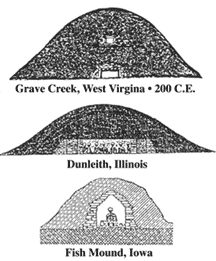 And on the East Coast, near Moundsville, West Virginia, a number of fort-like foundations can be found, including an octagon-shaped encirclement and other guard-post type "wells" in the hills along the river. Unfortunately, these are severely eroded, but the principal construction can still be found in the form of a large burial mound. In 1838, when Grave Creek Mound was originally excavated, it was discovered to contain passages similar to those in the Great Pyramid of Egypt. This earthen pyramid has a network of timber-supported tunnels leading to what appears to be a storage chamber at the middle, and to a burial tomb about seven feet below the surface of the ground. The skeletal remains of what appeared to be a man and woman were found in this lower chamber. Their teeth exhibited an unusual feature, in that the peaks of their molars were conically pointed in shape, as opposed to modern man’s, which are squared. Another grave was unearthed above the lower chamber, but below the upper one, which contained another skeleton in a very deteriorated state. There was also a small stone table with 22 runic-like hieroglyphics that was found while excavating near the mound. Luckily, plenty of drawings and casts were made of the object before it disappeared. Since then, "professional" archaeologists have declared it a fake.
And on the East Coast, near Moundsville, West Virginia, a number of fort-like foundations can be found, including an octagon-shaped encirclement and other guard-post type "wells" in the hills along the river. Unfortunately, these are severely eroded, but the principal construction can still be found in the form of a large burial mound. In 1838, when Grave Creek Mound was originally excavated, it was discovered to contain passages similar to those in the Great Pyramid of Egypt. This earthen pyramid has a network of timber-supported tunnels leading to what appears to be a storage chamber at the middle, and to a burial tomb about seven feet below the surface of the ground. The skeletal remains of what appeared to be a man and woman were found in this lower chamber. Their teeth exhibited an unusual feature, in that the peaks of their molars were conically pointed in shape, as opposed to modern man’s, which are squared. Another grave was unearthed above the lower chamber, but below the upper one, which contained another skeleton in a very deteriorated state. There was also a small stone table with 22 runic-like hieroglyphics that was found while excavating near the mound. Luckily, plenty of drawings and casts were made of the object before it disappeared. Since then, "professional" archaeologists have declared it a fake.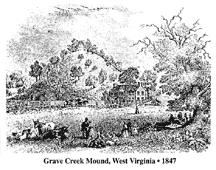 One last entry, out of many more of anomalous skeletons and skulls, is an account9 from the 1880s, of a group of distinguished antiquarians that excavated a burial mound near Tioga Point, Pennsylvania. Among those present were Professor W. K. Morehead of Phillips Andover Academy, Professor A. B. Skinner of the American Investigating Museum, and Dr. G. P. Donehoo, a Pennsylvania State historian and distinguished Presbyterian minister. During the dig they unearthed the remains of 68 males with an average height of seven feet. Some of the skulls had bony projections, two inches above the forehead, that appeared to be horn-like buds. Not surprisingly, some of these valuable artifacts were sent to the American Investigating Museum in Philadelphia, but, as usual, they have since disappeared and no one there knows anything about them.
One last entry, out of many more of anomalous skeletons and skulls, is an account9 from the 1880s, of a group of distinguished antiquarians that excavated a burial mound near Tioga Point, Pennsylvania. Among those present were Professor W. K. Morehead of Phillips Andover Academy, Professor A. B. Skinner of the American Investigating Museum, and Dr. G. P. Donehoo, a Pennsylvania State historian and distinguished Presbyterian minister. During the dig they unearthed the remains of 68 males with an average height of seven feet. Some of the skulls had bony projections, two inches above the forehead, that appeared to be horn-like buds. Not surprisingly, some of these valuable artifacts were sent to the American Investigating Museum in Philadelphia, but, as usual, they have since disappeared and no one there knows anything about them.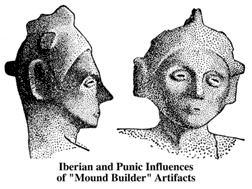 An important point that needs to be made is how few people realize that when the first Spanish explorers made contact in the New World a fair number of the tribes they encountered were of giant stature. Members of some of these tribes were on average 7 or 8 feet tall, with certain individuals being nearly 10 feet tall and possessing the greatest of strength. A number of the large skeletal remains that have been found, especially in some of the older and enigmatic mounds that dot the Midwestern and Southern landscapes, may indeed fall into the category of "native" burials and can very well be explained by conventional theories. On the other hand, some of the more bizarre claims, especially when observed as a whole, give the indication there may have been another species, similar to humans yet of a different physiology, that once inhabited North America.
An important point that needs to be made is how few people realize that when the first Spanish explorers made contact in the New World a fair number of the tribes they encountered were of giant stature. Members of some of these tribes were on average 7 or 8 feet tall, with certain individuals being nearly 10 feet tall and possessing the greatest of strength. A number of the large skeletal remains that have been found, especially in some of the older and enigmatic mounds that dot the Midwestern and Southern landscapes, may indeed fall into the category of "native" burials and can very well be explained by conventional theories. On the other hand, some of the more bizarre claims, especially when observed as a whole, give the indication there may have been another species, similar to humans yet of a different physiology, that once inhabited North America.
A RACE OF DWARFS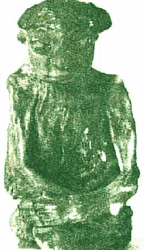 Another curiosity found amongst the mysteries of bizarre human-like remains are reports of miniature adult humanoid mummies. In one such instance,10 in October of 1932, two men were prospecting for gold in the Pedro Mountains of Wyoming when they found the mummified remains of what appeared to be a mature adult male. The miners were blasting near a stone-walled gulch, and when the dust settled they found the opening of a small cave about four-feet by four-feet and close to fifteen-feet deep. Inside they found the 14-inch tall San Pedro mummy, as it is now called, weighing about 12 ounces, with its arms and legs crossed, leaning perpendicularly upon a small ledge. According to the authorities, it did not appear to be the body of an infant because of the well-developed and proportional head, which would have been proportionally larger if it had been an infant. It had a broad, thin-lipped mouth, the nose was short and broad, the forehead was flattened, and the skin was a deeply-wrinkled dark brown.
Another curiosity found amongst the mysteries of bizarre human-like remains are reports of miniature adult humanoid mummies. In one such instance,10 in October of 1932, two men were prospecting for gold in the Pedro Mountains of Wyoming when they found the mummified remains of what appeared to be a mature adult male. The miners were blasting near a stone-walled gulch, and when the dust settled they found the opening of a small cave about four-feet by four-feet and close to fifteen-feet deep. Inside they found the 14-inch tall San Pedro mummy, as it is now called, weighing about 12 ounces, with its arms and legs crossed, leaning perpendicularly upon a small ledge. According to the authorities, it did not appear to be the body of an infant because of the well-developed and proportional head, which would have been proportionally larger if it had been an infant. It had a broad, thin-lipped mouth, the nose was short and broad, the forehead was flattened, and the skin was a deeply-wrinkled dark brown.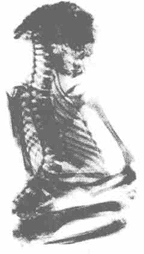 In an unusual display of confidence, the Harvard University Anthropological Department at one time attested for the authenticity of the mummy; the American Museum of Natural History’s Dr. Henry Shapiro confirmed that the mummy was of an unknown human type and of enormous age. The Egyptian Department at the Boston Museum indicated that it corresponds to the look of an Egyptian mummy that had been left unwrapped. At one time the Goodman Family owned this meaningful relic from our past, but they have since moved from the area. Another report claims that the artifact had been donated to the Smithsonian Institution, which, of course, has no record of it. However, the Chicago Field Museum of Natural History does have pictures of the unusual mummy.
In an unusual display of confidence, the Harvard University Anthropological Department at one time attested for the authenticity of the mummy; the American Museum of Natural History’s Dr. Henry Shapiro confirmed that the mummy was of an unknown human type and of enormous age. The Egyptian Department at the Boston Museum indicated that it corresponds to the look of an Egyptian mummy that had been left unwrapped. At one time the Goodman Family owned this meaningful relic from our past, but they have since moved from the area. Another report claims that the artifact had been donated to the Smithsonian Institution, which, of course, has no record of it. However, the Chicago Field Museum of Natural History does have pictures of the unusual mummy.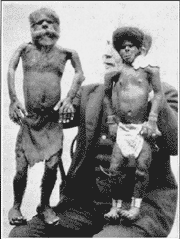 Another mysterious mummy was discovered deep inside of Mammoth Cave in Kentucky. The cave is one of the largest natural enclosures of its kind in the world. There has been a number of well preserved cadavers, or "Mammoth Cave mummies" as they are usually called, found here since the cave was first discovered in 1809. One of these mummies, found on a deep ledge of the cavern in 1920, was only three feet tall and had red hair. Another Mammoth Cave mummy has been on occasional display at the State Museum of Anthropology in Lexington.
Another mysterious mummy was discovered deep inside of Mammoth Cave in Kentucky. The cave is one of the largest natural enclosures of its kind in the world. There has been a number of well preserved cadavers, or "Mammoth Cave mummies" as they are usually called, found here since the cave was first discovered in 1809. One of these mummies, found on a deep ledge of the cavern in 1920, was only three feet tall and had red hair. Another Mammoth Cave mummy has been on occasional display at the State Museum of Anthropology in Lexington.
It has come to my attention that in addition to the unusually small mummies noted above, there have been a number of cases where "shrunken skeletons" have been made through the use of known mummification and embalming processes, resulting in the two small fellows pictured here. Notice the very human-like proportions and physiology which are unlike that of the San Pedro mummy.
ANCIENT MINING ACTIVITY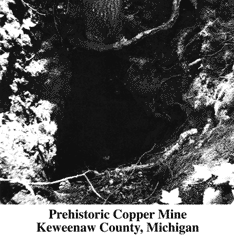 And then there’s the enigma of prehistoric mining. There are approximately 5,000 prehistoric pit mines11 of unknown age and origin found in northern Michigan that extend for about 100 miles along the south shore of Lake Superior. Also known as the Arcadian Copper Mines, this is one of the only places on Earth where copper can be found in large quantities in its raw form, as chunks and nuggets. A massive amount, anywhere from 100 million to 500 million pounds, of pure copper appears to have been extracted from these sites. There are still several copper mines functioning in the area and every one of them is located on a site that had been mined in the prehistoric past. However, there has been almost no evidence of any human habitation or settlements, nor any animal bones or human burials anywhere in the area. And yet, the technical engineering that was employed in the construction of some of the mines indicates a highly specialized and organized civilization. In addition, there have been some unusual idol-like artifacts that have been found in the region; some of these can still be found at a private museum in Marble, North Carolina.
And then there’s the enigma of prehistoric mining. There are approximately 5,000 prehistoric pit mines11 of unknown age and origin found in northern Michigan that extend for about 100 miles along the south shore of Lake Superior. Also known as the Arcadian Copper Mines, this is one of the only places on Earth where copper can be found in large quantities in its raw form, as chunks and nuggets. A massive amount, anywhere from 100 million to 500 million pounds, of pure copper appears to have been extracted from these sites. There are still several copper mines functioning in the area and every one of them is located on a site that had been mined in the prehistoric past. However, there has been almost no evidence of any human habitation or settlements, nor any animal bones or human burials anywhere in the area. And yet, the technical engineering that was employed in the construction of some of the mines indicates a highly specialized and organized civilization. In addition, there have been some unusual idol-like artifacts that have been found in the region; some of these can still be found at a private museum in Marble, North Carolina.
Native Americans had no interest in the mines, besides, few aborigine tribes had much use for copper. There are several so-called "Indian" burial mounds, notably in Fall River, MA and Walkerton, IN, that when excavated in the 19th century yielded skeletal remains (up to 9 feet tall) which wore copper artifacts, including copper and/or bronze armor. Dr. Eiler, an archaeologist from Carleton College in Minnesota, has hypothesized that Near-Eastern explorers might have been in the area to mine metals. While commenting on the Indian theory as to the origins of the copper workings Charles Fort wrote: "I think that we’ve had visitors [and] that they have come here for copper, for instance."
Evidence of mining activity and underground tunnel systems in prehistoric North America are not uncommon. Take for example a report12 that, in 1954, a pair of existing tunnels were discovered while working a mine owned by the Lion Coal Corporation near Wattis, Utah. At an approximate depth of 8,500 feet, miners found pockets of coal that had been heavily oxidized. Further digging revealed the tunnels, 200 feet apart, that were partially filled with crumpled rock and coal, but that had been mined from both sides. No record of any other mining activity in the area has been recorded and no entrances have ever been found. Due to the nature of mining activity there is no doubt that the location of the tunnels has been lost to history.
UNDERGROUND CAVERNS AND TUNNEL SYSTEMS
Besides evidence of ancient mining, there are also a number of underground chambers and tunnels which have been found over the years. For example, in 1962, Consolidated Edison had planned on building a large electric plant at the north end of where East River Park now stands in New York. When a preliminary soil test was conducted with a large core drilling, at the 200-foot level, the drill reportedly punched through to a large underground cavern of unascertainable size. As the story goes, the hole was secretly filled in and Consolidated Edison built a nice park over it.
Ten years later, in September 1972, a spokesman for the J.F. Barrett Company of Devon reported finding an unusual tunnel while excavating in Milford, Connecticut for a new sewer. The tunnel appeared to be made partially from dry stone masonry and was more than 200 feet long. At one point there was a masonry arch approximately ten feet across and ten feet high. Naturally, the workmen were there to install a sewer, finished the job as expected, and that’s the last anyone’s heard about it.
There is also a series of subterranean tunnel systems that have been made from arched masonry structures, found beneath Memphis, Tennessee. The establishment claims that they were built by the military during the civil war. The tunnels that are accessible show a high degree of skill and workmanship, and a great expense of time went into building them, not likely in time of war. There is an entrance to one of them at the east end of Harahan Bridge on I-55. The entrance is between Indiana and Delaware Streets, to the right heading east on Crump Boulevard. It is said to lead to a bigger tunnel that runs lateral to the Mississippi River north along South Third Street towards the center of the city.
And in Lexington, Kentucky, there was a report by G. W. Ranck in the 1872 History of Lexington describing a gallery of tunnels somewhere beneath this city. The report detailed how, in 1776, hunters from the frontier town of Booneborough found rocks of "peculiar workmanship," behind which was found a tunnel. The small opening inclined sharply into the rock and enlarged to a grand gallery about four feet wide and seven feet high. After a few hundred feet the gallery led to an even larger chamber that was 18 feet high, 100 feet wide and 300 feet in length. Inside of this chamber were found an altar, idols, and about 2,000 human mummies.
SMALLER TUNNELS
Apparently unusual tunnels come in all sizes. In the summer of 1973, in Croften, Maryland, during excavation for a parking lot, workmen found a collection of tunnels which were about 20 inches in diameter. An amateur archaeologist, William Doepkins, concluded that they may have been made by a large rodent, from the claw and tooth marks that were found on the walls. Naturally, the habitat of those oversized rodents was only superficially explored, the lot was leveled, and a parking lot was built over this unusual find.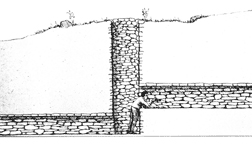 There is a well-documented case of an unknown tunnel, that originally was discovered in the late 1800s. When searching for a rabbit, a group of hunters discovered an ancient tunnel system made from mortarless dry masonry near the cemetery in Goshen, Massachusetts. The rabbit had jumped into a burrow near the top of a vertical shaft that had been concealed with flagstones covered with sod and shrubbery. The shaft is three and half feet in diameter and about fifteen feet deep, with two horizontal tunnels that branch off, one at the bottom running eastward, and another three feet from the bottom, which travels westward. The tunnels are about two feet wide and about two and a half feet high with flagstone ceilings supported by sidewalls made of stone. The bottom shaft travels about 75 feet, and the upper one about 15 feet, before reaching points where they have collapsed.
There is a well-documented case of an unknown tunnel, that originally was discovered in the late 1800s. When searching for a rabbit, a group of hunters discovered an ancient tunnel system made from mortarless dry masonry near the cemetery in Goshen, Massachusetts. The rabbit had jumped into a burrow near the top of a vertical shaft that had been concealed with flagstones covered with sod and shrubbery. The shaft is three and half feet in diameter and about fifteen feet deep, with two horizontal tunnels that branch off, one at the bottom running eastward, and another three feet from the bottom, which travels westward. The tunnels are about two feet wide and about two and a half feet high with flagstone ceilings supported by sidewalls made of stone. The bottom shaft travels about 75 feet, and the upper one about 15 feet, before reaching points where they have collapsed.
There have been a number of theories as to its origin and purpose. One theory is that settlers built it as a shelter from Indian attacks, though none are known to have occurred in the area. Another is that is was part of the "underground railroad," though it was hardly practical for that use. Or that is was a water well, but then why the horizontal shafts, which according to engineers required an enormous amount of effort to bore such narrow shafts, especially in such dense hardpan, at such an unusual right angle, and in such a confined workspace. The structure has more recently been known as "Counterfeiter’s Den," from the story that counterfeiters were once caught several miles southwest of the site.
UNDERGROUND CITIES
There is a Piute, or Paiute, Indian legend of an underground city below Death Valley, that they refer to as Shin-Au-av. An Indian guide in the 1920s, Tom Wilson, claimed that his grandfather had discovered catacombs below the ground in the area. He says that they led to an underground city where people spoke an unknown language and wore leather-like clothing. Also in the Death Valley area, a prospector by the name of White says that he had fallen from an abandoned mine near Wingate Pass into a mysterious tunnel. He claims he followed the tunnel which led to a succession of rooms in which he found stacks of gold bricks guarded by hundreds of humanoid mummies that were clad in leather. It is interesting to note that when times were tough Walter Scotty, of nearby Scotty’s Castle fame, would wander in the desert for a few days at a time and bring back processed gold that he said he had prospected.
Around the turn of the century, near the city of Chehalis, Washington, there was a man named H F. Forest that claimed he had been prospecting when he came upon a large flat rock "which had been hewn from human hands." He removed the rock and found a cave entrance on the south side of Mount Rainier. He entered the cave and discovered an enclosure about 12-feet high and 60-feet wide, on whose smoothly polished walls could be found "hieroglyphics and figures made by human hands." He explored to a depth of about five miles, occasionally encountering side passages containing ice caves, sulfur springs, hot springs, and cold springs. At one location he came upon human-size bathtubs which had been carved into the bedrock with converging streams of water entering them. Forrest then reportedly came upon an immense underground lake, where a large canoe was chained with silver links to the wall. He removed the canoe and explored the enormous lake for more than a mile in each direction, without reaching shore. Later he came upon a side passage with heavy vaults, one of whose lids was ajar. Inside he found the bodies of two people, a man and a woman, reportedly between seven and eight feet in height. Both had been laid out on slabs of ice, and were perfectly preserved in a completely frozen state. Forrest left town on 16 Mar 1901, and was never heard from again.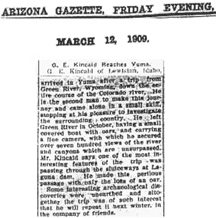 In another report, reminiscent of a scene from The Twilight Zone, a traveler to the Mojave Desert north of Baker, California claims he found a small habitation of about 30 dwellings, arranged as a planned community, that had been partially unburied by the shifting of the sands. The structures were said to have been built of wood with massive handmade room timbers. He also claims that there were heavy wooden tables that had been set for a meal. There are no trees found for miles around, nor is there any record of any mining, or other settlement, in the area.
In another report, reminiscent of a scene from The Twilight Zone, a traveler to the Mojave Desert north of Baker, California claims he found a small habitation of about 30 dwellings, arranged as a planned community, that had been partially unburied by the shifting of the sands. The structures were said to have been built of wood with massive handmade room timbers. He also claims that there were heavy wooden tables that had been set for a meal. There are no trees found for miles around, nor is there any record of any mining, or other settlement, in the area.
The grand-daddy of all underground city stories can be read in the accompanying article that appeared in the April 5th, 1909 Phoenix Gazette. It describes an underground city in the Grand Canyon that contained a number of unusual artifacts. And the grand-daddy of all underground city stories can be read in this article that appeared in the 05 Apr 1909 Phoenix Gazette.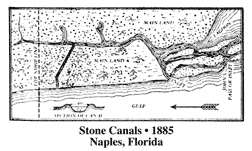 In the 1880s, geologist Andrew Douglass described13 an ancient canal that ran for a mile and a half between the Naples, Florida, Bay and the Gulf of Mexico. The mysterious canal is "straight as an arrow," about 55 feet across and up to 40 feet deep in places, slicing through both plateaus and sand banks. The bottom of the canal narrows to about twelve feet, and has a two-foot-deep trench about four feet across running down the center. Douglass thought this trench might have been for the keel of a boat. Douglass also wrote "it was a work of enormous labor;" but the question is, what was the purpose, and who in this meagerly populated area could have undertaken it?
In the 1880s, geologist Andrew Douglass described13 an ancient canal that ran for a mile and a half between the Naples, Florida, Bay and the Gulf of Mexico. The mysterious canal is "straight as an arrow," about 55 feet across and up to 40 feet deep in places, slicing through both plateaus and sand banks. The bottom of the canal narrows to about twelve feet, and has a two-foot-deep trench about four feet across running down the center. Douglass thought this trench might have been for the keel of a boat. Douglass also wrote "it was a work of enormous labor;" but the question is, what was the purpose, and who in this meagerly populated area could have undertaken it?
Other canals have been found as well, in particular the remains from the Hohokam Indians in the area near present-day Phoenix, Arizona. Their canals were lined with caliche, a type of cement that allowed them to irrigate much of the Salt and Gila river valleys and create a desert paradise. The Hohokam had built about 250 miles of canals that date from about the year 1300. Some of the old canals can still be seen in various locations, whereas many of the modern canals that crisscross the greater-metropolitan Phoenix area no doubt follow the same routes.
ARTIFACTS UNEARTHED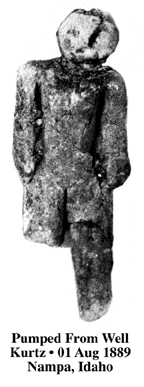 There have been a number of artifacts which have been brought up from below ground that have baffled the authorities. In August,1889, an object that has become known as the "Nampa Image" was reportedly14 pumped up from a well on the property of M. A. Kurtz, a professional well-driller from the Nampa, Idaho area. Kurtz and two workmen claim they were drilling through coarse sand at the 300-foot level when the artifact was brought up by the machinery. The object is obviously humanoid, and is a brownish piece of clay an inch and a half in length. The image had been sent back East for analysis and a professor at Oberlin College, Albert A. Wright, found it was half clay and half quartz, and that the fractured right leg was not recent. Then, Dr. G. Frederick Wright (no relation), of the Boston Society of Natural History went to Nampa to investigate the circumstances in which it was discovered. He inspected the steam-driven pump and drilling machinery. He then questioned Kurtz at length, and reported to the Society that "there is no grounds to question the fact that this image came up in the sand pump from the depth reported." Professor F. W. Putnam, also of Boston, stated "the cementing of quartz grains by iron molecules under the image’s right arm was evidence of great age." The Idaho State Historical Society, in Boise, has retained caretakership of the artifact, one of only a few surviving objects of a similar nature that have been found in America.
There have been a number of artifacts which have been brought up from below ground that have baffled the authorities. In August,1889, an object that has become known as the "Nampa Image" was reportedly14 pumped up from a well on the property of M. A. Kurtz, a professional well-driller from the Nampa, Idaho area. Kurtz and two workmen claim they were drilling through coarse sand at the 300-foot level when the artifact was brought up by the machinery. The object is obviously humanoid, and is a brownish piece of clay an inch and a half in length. The image had been sent back East for analysis and a professor at Oberlin College, Albert A. Wright, found it was half clay and half quartz, and that the fractured right leg was not recent. Then, Dr. G. Frederick Wright (no relation), of the Boston Society of Natural History went to Nampa to investigate the circumstances in which it was discovered. He inspected the steam-driven pump and drilling machinery. He then questioned Kurtz at length, and reported to the Society that "there is no grounds to question the fact that this image came up in the sand pump from the depth reported." Professor F. W. Putnam, also of Boston, stated "the cementing of quartz grains by iron molecules under the image’s right arm was evidence of great age." The Idaho State Historical Society, in Boise, has retained caretakership of the artifact, one of only a few surviving objects of a similar nature that have been found in America.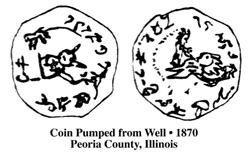 In another similar report,15 from August 1870, near Lawnridge, Illinois, there was an artifact that was brought up with drilling residues while boring an artesian well at a depth of 125 feet, according to Jacob W. Moffit of Chillicothe. The coin-like object was about the size of a quarter-dollar of the era. The illustration shows a man-like being riding some sort of bird. Scientist William E. DuBois examined the coin carefully and stated that the coin showed no signs of hammering and the patterns on it appeared to have been etched with chemicals, rather than being stamped or engraved. DuBois also felt that the coin must have been passed through a rolling mill and that there were other signs of work in a machine shop. He concluded by stating "how it got into such a deep place, supposing it to be a bona fide discovery, which I cannot call into question, is a very perplexing point . . ."
In another similar report,15 from August 1870, near Lawnridge, Illinois, there was an artifact that was brought up with drilling residues while boring an artesian well at a depth of 125 feet, according to Jacob W. Moffit of Chillicothe. The coin-like object was about the size of a quarter-dollar of the era. The illustration shows a man-like being riding some sort of bird. Scientist William E. DuBois examined the coin carefully and stated that the coin showed no signs of hammering and the patterns on it appeared to have been etched with chemicals, rather than being stamped or engraved. DuBois also felt that the coin must have been passed through a rolling mill and that there were other signs of work in a machine shop. He concluded by stating "how it got into such a deep place, supposing it to be a bona fide discovery, which I cannot call into question, is a very perplexing point . . ."
And this most unusual report,16 from 1851, of an unusual object unearthed in Dorchester, Massachusetts while blasting to expand a house of worship operated by the Reverend Mr. Hall. Amongst the tons of debris scattered about, workmen discovered a "metallic vessel in two parts." The object was approximately four inches wide by six inches high, was bell-shaped, and showed a high degree of craftsmanship. Apparently, it had been blown out of solid pudding stone from 15 feet below the surface. The Scientific American stated that it was satisfied that it had occurred as reported. It was believed to be an alloy of silver and zinc and had six figures of a bouquet around the circumference and a wreath-like decoration around the base, both of which had been beautifully inlaid with silver.
THE COGSTONES OF THE TOPANGA CULTURE
Artifacts of significant archaeological interest have been found17 throughout the Los Angeles basin, the western half of San Diego county, and on certain isles in the Channel Islands chain not far from shore. The most famous relics from this lost civilization are known as the "cog stones of the Topanga Culture" and have been found mostly in the Bolsa Chica State Beach area. These California cog stones, as they are commonly called, are gear-like stones ranging in size from two to six inches in diameter, with a thickness up to two inches. The cog stones come with different characteristics such as cups, cusps, hemispherical grooves and dents, sprocketed teeth around the edges, as well as cookie-cutter patterns. Most all of these features occur at precise and repeating intervals, and about 15 percent had a single hole bored through the center. Many times these holes are narrower on one side, have elliptical sides, are conical, or double conical, where the entry point holes are narrower on either side than at the midpoint.
One of the artifacts in particular has a striking anomaly in that it has perfectly square perforation in the middle, something that would be troublesome to duplicate even with our present machine shop technology. Many of the cog stones are found at the circa 6,000 B.C.E. strata, containing artifacts that are some of the most primitive found in North America. The uniqueness of these artifacts are not so much their being found primarily at the estimated 8,000 year old level, but in the fact that a cog-stone-only level occurs below this one that is of a correspondingly older age. It seems pretty obvious that the later peoples may have found the relics of the previous culture and they thus became deposited in their strata. Questions remain on the origins of this earlier tribe.
ROMAN RELICS OFARIZONA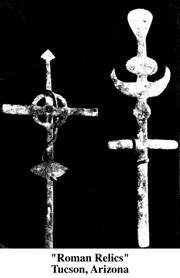 More unusual artifacts were unearthed18in 1924, when Charles E. Manier found a riveted lead cross and other artifacts of a mysterious nature near Tucson, Arizona. The cross had been protruding from where the roadway had cut through an embankment on a bluff on the west side of the Santa Cruz River. Nearly three dozen artifacts were eventually found at this site. One of the first crosses to be unearthed was bound together by rivets; and when each half was separated they revealed Latin and Hebrew inscriptions, but of an unknown style and form.
More unusual artifacts were unearthed18in 1924, when Charles E. Manier found a riveted lead cross and other artifacts of a mysterious nature near Tucson, Arizona. The cross had been protruding from where the roadway had cut through an embankment on a bluff on the west side of the Santa Cruz River. Nearly three dozen artifacts were eventually found at this site. One of the first crosses to be unearthed was bound together by rivets; and when each half was separated they revealed Latin and Hebrew inscriptions, but of an unknown style and form.
Reminiscent of Havisupal Canyon, one of the crosses had, as its only inscription, a depiction of what could only be a dinosaur. A number of the symbols revealed possible mystical origins, including emblems of freemasonry, in particular the Masonic square and compass. Another cross that was found had a snake entwined around it and displayed a number of indecipherable symbols and a few Hebrew letters. Many of the artifacts have an esoteric element associated with them in one way or another.
Manier and his friend Thomas Bent, who owned the property and therefore the artifacts, had brought in skilled professionals with irreproachable credentials to assist in the excavation. The establishment’s final verdict was that a catholic boy of Hispanic decent, Vicente Odohui, who had lived in the area; or possibly Mormons trying to support doctrine, had planted the artifacts beforehand.
Wednesday, May 13, 2009
+ Pathways to Higher Consciousness - Understanding the PINEAL GLAND and the Development of the "GOD HELMET" by Tedd St. Rain +
"PATHWAYS TO HIGHER CONSCIOUSNESS - UNDERSTANDING THE PINEAL GLAND AND THE DEVELOPMENT OF THE "GOD HELMET" (OR) HOW TO STIMULATE YOUR MIND'S EYE WITH DIRECTED COUNTER-ROTATING ELECTROMAGNETIC FIELDS, by Tédd St. Rain

The human endocrine system, as you may know, it's composed of various glands, the hypothalmus, the pituitary, the adrenals, etc, and also various 'transport systems' (aka 'neuroendocrine pathways'). And so, deep within the brain, at the very center of our skull, lodged just beneath our two CEREBRAL HEMISPHERES, is the PINEAL GLAND, and it works hand-in-hand with the nearby Pituitary Gland, aka 'The Master Gland'. So it's this PINEAL GLAND that is interest to us here. http://en.wikipedia.org/wiki/Pineal_gland you've probably heard of it, it's best known for producing MELATONIN, which regulates our sleep/wake patterns, and thus OUR CONSCIOUSNESS (did you know that our natural body state is to be in a COMA, it's only our hormones and endocrines that keep up AWAKE and conscious), though science still can't fully explain exactly how the pineal gland works, or how it produces HALLUCINATIONS IN THE MIND when stimulated in the 'right way', like when you trip on acid or have a DMT 'experience', and so, when your 'trippin', this gland becomes fully-activated, and it quite literally 'pulses' in a certain rhythmic fashion, whereas 'normally' it's quite dormant in everyday life, and in older adults, especially, it becomes withered and 'calcified' (see below for the 'FLUORIDE CONSPIRACY')...
and then there's the egyptian 'eye of horus' connection:

but we won't go there...
as somewhat of a 'side bar', it is interesting to note that there are actually very few ways that the 'outside world' can 'communicate' with 'our consciousness' directly, sure, we have our 5, or 6 senses, and certain limbic responses, and of course, we use HUMAN LANGUAGE AS OUR PRIMARY METHOD OF COMMUNICATION, but did you know, that there's also another way, a BACK DOOR to mind, a HIDDEN PATHWAY into our brain's subconscious, that's been HARD-WIRED INTO EACH OF US since the 'dawn of man' - ie: while listening to 'CERTAIN' RHYTHMS OF MUSICAL NOTES!!!

so, there's this shortcut to our subconscious, and naturally, some frequencies work better than others, for example 2 beats per second, or around 120 beats a minute seems to be the ideal rhytmn to open this pathway, does that sound familiar? http://en.wikipedia.org/wiki/Beats_per_minute ie: it's the TEMPO OF HOUSE MUSIC, and so, when the BRAIN ENTRAINS to these 'musical frequencies', it's opening up a 'carrier' deep withing the mind, and so 'THE MESSAGE' get's heard LOUD AND CLEAR, though we don't normally realize it. http://en.wikipedia.org/wiki/Music_and_the_brain

and then we come to "BINAURAL BEATS" or "HEMISPHERIC SYNCRONIZATION" ie: Hemi-Synch™ for short, developed by Robert Monroe in the 1970s, and 'furthered to this day' by the Monroe Institute, which has created (and patented) a series of mediation tapes, which use specific FREQUENCY AND SOUND WAVES to 'ARTIFICIALLY' ENTRAIN BRAIN WAVE FUNCTION, though it only works by using STEREO HEADPHONES (or specially designed acoustic labs), the basic premise is that you play one frequency in one ear, and another freq in the other, and not-suprisingly, the brain SUBTRACTS THE DIFFERENCE, and interprets it as a THIRD SOUND, ie: a Binaural Beat... This ALSO opens a special pathway that can be used for non-verbal communication. http://en.wikipedia.org/wiki/Hemisync
http://en.wikipedia.org/wiki/Robert_Monroe

and then along came 'MICHAEL PERSINGER", http://en.wikipedia.org/wiki/Michael_Persinger who in the 1980s used 'transcranial magnetic stimulation' to INDUCE RELIGIOUS EXPERIENCES and/or DRUG-LIKE HALLUCINATIONS in about 80% of the subjects who tried his device, some reported SEEING JESUS, others reported feeling THE PRESENCE OF GOD in the room, ie: where the device gets it's nickname: THE GOD HELMET!!! http://en.wikipedia.org/wiki/God_helmet

and new, updated god-helmets can be acquired:
http://www.shaktitechnology.com
http://www.shaktitechnology.com/god_helmet.htm

---
and, of course, there's always 'got to be' a good conspiracy associated with all good stories, and this subject is no different, i'm not sure how much you know about 'fluoride', and how it's a deadly poison, that the germans were using for chemical experiments, 'human willpower' manipulation, mind control, etc... it is so toxic, that in this country, they used to have to treat it as a toxic waste, and pay to have it disposed of properly... until lobbyists for the aluminum industry (ie: ALCOA, the largest producer of the stuff) got the government to dump it in our water, and thus, food supply... THE POINT IS: research has shown that ingesting fluoride regularly causes the PINEAL GLAND to calcify and shut down, never to be 'young and pliable' again, awww... "use it, or lose it" my friends...


history of fluoridation:
http://www.informationliberation.com/?id=14949
